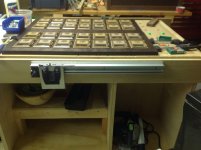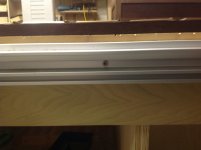Really have created a bit of a dilemma for myself. So looking for some guidance.
I have a work surface that I am just completing that is 48" on a side fully assembled. It has 20mm holes, 96mm spacing....mft style.
But I realize that what it lacks is the mft's extruded aluminum side rails where so much that is mft is attached. Added to the equation, my TS is the 75. I would not give up my 75 for a 55 but the added size of my 48 x 48 really is a help given the added size of the 75. Plus the foundation of the build work surface is the C470 saw horses. all I need do to expand to full 4' x 8' sheet size is remove my surface, separate the horses, drop in a couple of longer 2 x 4s and toss a full sheet across everything.
The problem is that a basic mft/3 is hardly less money than a full blown mft/3. Yet I am not real convinced I have use for the stuff that makes a complete mft/3. The dif is like the cost of a 42" rail which I also have which is somewhat galling under the circumstances.
Does it make any sense to buy a basic at all even given that I already have the rail that comes on a full blown mft/3 and a bunch of the festool clamping and clamping element fixtures and dogs that would work with any mft of this generation.
Since I am really looking for the clamping that comes from having the the extruded side rails of the mft systems, does it make more sense to buy an mft/3-kapex as opposed to either an mft/3 with everything an mft/3 basic even though the Kapex version is smaller still?
I suppose I could argue to myself that the kapex version takes up less room and would give me the side rails that would allow me more use of my Festool clamps and the various bench dogs that I have. I am also supposing that the smaller size of the kapex means it is more stable without adding the expense of the support legs. It is lighter than an mft/3 basic but all of the corner hardware looks the same and the extrusions and legs look like they are made of the same stuff. I am hoping that would mean a kapex version would in fact be more stable.
I really sort of backed myself into this dilemma. But it is all my own doing really. Can't blame anybody but myself for this predicament. So from where I am, what makes the most sense to you guys:
1) get an mft3-kapex
2) get an mft3-basic
3) get a full blown mft3
4) wait and see if something opens up on the used or open box market
5) get a rope and hang myself
I have a work surface that I am just completing that is 48" on a side fully assembled. It has 20mm holes, 96mm spacing....mft style.
But I realize that what it lacks is the mft's extruded aluminum side rails where so much that is mft is attached. Added to the equation, my TS is the 75. I would not give up my 75 for a 55 but the added size of my 48 x 48 really is a help given the added size of the 75. Plus the foundation of the build work surface is the C470 saw horses. all I need do to expand to full 4' x 8' sheet size is remove my surface, separate the horses, drop in a couple of longer 2 x 4s and toss a full sheet across everything.
The problem is that a basic mft/3 is hardly less money than a full blown mft/3. Yet I am not real convinced I have use for the stuff that makes a complete mft/3. The dif is like the cost of a 42" rail which I also have which is somewhat galling under the circumstances.
Does it make any sense to buy a basic at all even given that I already have the rail that comes on a full blown mft/3 and a bunch of the festool clamping and clamping element fixtures and dogs that would work with any mft of this generation.
Since I am really looking for the clamping that comes from having the the extruded side rails of the mft systems, does it make more sense to buy an mft/3-kapex as opposed to either an mft/3 with everything an mft/3 basic even though the Kapex version is smaller still?
I suppose I could argue to myself that the kapex version takes up less room and would give me the side rails that would allow me more use of my Festool clamps and the various bench dogs that I have. I am also supposing that the smaller size of the kapex means it is more stable without adding the expense of the support legs. It is lighter than an mft/3 basic but all of the corner hardware looks the same and the extrusions and legs look like they are made of the same stuff. I am hoping that would mean a kapex version would in fact be more stable.
I really sort of backed myself into this dilemma. But it is all my own doing really. Can't blame anybody but myself for this predicament. So from where I am, what makes the most sense to you guys:
1) get an mft3-kapex
2) get an mft3-basic
3) get a full blown mft3
4) wait and see if something opens up on the used or open box market
5) get a rope and hang myself




